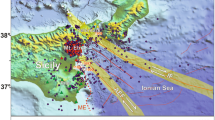Abstract
The collected GPS/GLONASS data allow us to reveal new information on the recent geodynamics of the Kuril Island arc. The maximum deformation stress accumulates in the southern and northern parts of the study area, while a long fading transition process of postseismic motions is observed in the central segment of the Kuril arc as a result of the 2006–2007 great Simushir earthquakes of M w = 8.3 and M w = 8.1. We have succeeded in revealing the recent interplate coupling geometry of the Pacific and the North American lithospheric plates and also in estimating the seismic potential of different segments of the Kuril subduction zone.
Similar content being viewed by others
References
M. Yu. Andreeva and Ch. U. Kim, Earthquakes of the Kuril–Kamchatka Region (1737–2009) (IMGiG DVO RAN, Yuzhno-Sakhalinsk, 2012) [in Russian].
L. M. Balakina, “Kuril–Kamchatka seismogenic zone: structure and order of the earthquake generation,” Fiz. Zemli, No. 12, 48–57 (1995).
G. M. Steblov, N. F. Vasilenko, A. S. Prytkov, et al., “Dynamics of the Kuril-Kamchatka subduction zone from GPS data,” Izv., Phys. Solid Earth, 46 (5), 440–445 (2010).
R. Z. Tarakanov, “Sizes of Focal Zones of strong earthquakes of the Kuril–Kamchatka region and Japan and problem of maximally possible magnitudes,” Vulkanol. Seismol., No. 1, 76–89 (1995).
I. N. Tikhonov and B. V. Levin, “Prediction of strong earthquakes of the Sakhalin district: history, results, and prospects,” in Proceedings of Conference with International Participation “Geodynamic Processes and Natural Catastrophes. Neftegorsk Experience,” Yuzhno-Sakhalinsk, Russia, 2015, (Yuzhno-Sakhalinsk, 2015), pp. 41–45 [in Russian].
S. A. Fedotov, A. V. Solomatin, and S. D. Chernyshev, “A long-term earthquake forecast for the Kuril–Kamchatka arc for the period from September 2010 to August 2015 and the reliability of previous forecasts, as well as their applications,” J. Volcanol. Seismol., 5 (2), 75–99 (2011).
E. V. Apel, R. Burgmann, G. Steblov, et al., “Independent active microplate tectonics of Northeast Asia from GPS velocities and block modeling,” Geophys. Res. Lett. 33, L11303 (2006).
G. P. Hayes, D. J. Wald, and R. L. Johnson, “Slab 1.0: a three dimensional model of global subduction zone geometries,” J. Geo-Phys. Res. 117, 1–15 (2012).
http://iris.edu
M. G. Kogan and G. M. Steblov, “Current global plate kinematics from GPS (1995–2007) with the plate consistent reference frame,” J. Geophys. Res. 113, B04416 (2008). 2007JB005353.
M. G. Kogan, N. F. Vasilenko, D. I. Frolov, et al., “The mechanism of postseismic deformation triggered by the 2006–2007 Great Kuril earthquakes,” Geophys. Res. Lett. (2011). 2011GL046855
M. G. Kogan, N. F. Vasilenko, D. I. Frolov, et al., “Rapid postseismic relaxation after the great 2006–2007 Kuril earthquakes from GPS observations in 2007–2011,” J. Geophys. Res. 118, 1–16 (2013). doi 10.1002/jgrb.50245
J. C. Savage, J. L. Svarc, and W. H. Prescott, “Deformation across the Alaska–Aleutian subduction zone near Kodiak,” Geophys. Res. Lett. 26, 2117–2120 (1999).
N. V. Shestakov, H. Takahashi, M. Ohzono, et al., “Analysis of the far-field crustal displacements caused by the 2011 Great Tohoku earthquake inferred from continuous GPS observations,” Tectonophysics 524–525, 76–86 (2012).
G. M. Steblov, M. G. Kogan, B. W. Levin, et al., “Spatially linked Asperities of the 2006–2007 Great Kuril earthquakes revealed by GPS,” Geophys. Res. Lett. 35, L22306 (2008). doi 10.1029/2009GL035572
G. M. Steblov, G. Ekstrom, M. G. Kogan, et al., “First geodetic observations of a deep earthquake: the 2013 Sea of Okhotsk A/W 8.3 Event,” Geophys. Res. Lett. 41 (11), 3826–3832 (2014). doi 10.1002/ 2014GL060003
Author information
Authors and Affiliations
Corresponding author
Additional information
Original Russian Text © A.S. Prytkov, N.F. Vasilenko, D.I. Frolov, 2017, published in Tikhookeanskaya Geologiya, 2017, Vol. 36, No. 1, pp. 21–26.
Rights and permissions
About this article
Cite this article
Prytkov, A.S., Vasilenko, N.F. & Frolov, D.I. Recent geodynamics of the Kuril subduction zone. Russ. J. of Pac. Geol. 11, 19–24 (2017). https://doi.org/10.1134/S1819714017010067
Received:
Published:
Issue Date:
DOI: https://doi.org/10.1134/S1819714017010067




